Curing turns ordinary ribs into something extraordinary — bacon back ribs!
Looking for something a little different for your next cookout? These bacon-style baby back ribs will have your guests buzzing.
Inspired by our popular homemade bacon recipe, you cure the baby backs for 3 days. If you are new to curing meats, we recommend you read our Science of Curing Meats Safely article, as too much of the sodium nitrite preservative found in curing salt (Prague Powder #1 or #2) can be dangerous if too much is used.
Once the three-day curing process is complete, rinse the curing mixture off the ribs, then coat them with a thin layer of mayonnaise* and season them with our homemade Meathead’s Memphis Dust BBQ dry rub. Smoke the racks until they turn juicy and tender — not fall-off-the-bone, which means they’re overdone. Plan on about 4 1/2 hours.
If you prefer to utilize the Texas Crutch (wrapping the ribs in foil or butcher paper to boost tenderness), wrap them during the last 45 minutes of the cook. I wait until the meat pulls back from the bone by 1/2 to 3/4 inch before wrapping. Remember that wrapping essentially steams the ribs, especially in foil, so anything longer than 45 minutes can push them past done.
Once the ribs finish cooking, you can keep them naked like I do to let the bacon/ham flavor shine. If you’d rather sauce them, brush it on during the final few minutes so it can set and turn tacky. After that, slice and serve your bacon back ribs to the hungry crowd.

What Are Bacon Ribs?
Bacon ribs are baby back ribs that get treated like bacon.
First you cure the ribs, just like in our step-by-step homemade bacon recipe. Then you smoke them low and slow like traditional smoked baby back ribs.
The result? Ribs that taste like bacon and ham had a delicious little barbecue baby. Same rib chew. Big bacon aroma. Deep pink color from the cure.
If you are new to curing, start with our science-backed guide to the science of curing meats safely. Curing salts like Prague Powder #1 and #2 are safe when used correctly. Too much can be dangerous. Measure carefully.
Why This Recipe Works
- Curing builds bacon flavor
The cure adds salt, sugar, and nitrite to the ribs. The curing mix is what gives bacon its signature flavor and rosy color. - Baby backs stay juicy
We use baby back ribs so the texture stays tender, not ham-dry. You get bacon flavor with the proper rib bite. - A dry rub adds bark and balance
Meathead’s famous Memphis Dust BBQ dry rub brings sweetness, spice, and a gorgeous crust to the ribs. It plays nice with the cure instead of fighting it. - Controlled smoke and time
We smoke low and slow for about 4 1/2 hours. That’s enough time for the ribs to get tender and smoky. Not long enough to cook them to mush. - Texas Crutch is optional, not a crutch
You can use the Texas Crutch for ribs to boost tenderness. We keep it short so you don’t steam the bacon ribs into oblivion.
Ingredients & Substitutions
Use your favorite brands, but don’t wing the cure amounts.
- Baby back ribs
The base for bacon ribs. Look for meaty racks with good marbling. Learn how to shop in our gold-standard ribs recipe, which includes a guide to buying ribs. No baby backs? You can try this method on St. Louis cut ribs, but plan on a bit more cook time. See our St. Louis-style spare ribs recipe. - Curing salt (Prague Powder #1)
Provides the bacon flavor, pink color, and food safety. Always follow our curing salt safety guide and use our curing calculator for precise amounts. Do not substitute regular salt. - Kosher salt
For seasoning balance along with the cure. Kosher salt is easier to measure than table salt. If you must use table salt, reduce the amount by about 25%. - Sugar (white or brown)
Balances the salt and cure, and it helps with browning. Brown sugar adds a hint of molasses. See more options in our best sugars for barbecue. Prefer less sugar? Try reducing the amount. You may be able to use almost half as much before it starts to taste like it’s missing something. - Mayonnaise
Acts as a flavorful glue for the rub. Helps browning. Don’t worry, it won’t taste like egg salad. No mayo? Use mustard instead. - Meathead’s Memphis Dust BBQ dry rub
The star rub here. Sweet, savory, and designed for pork. Get the full recipe at Meathead’s Memphis Dust rub. - Wood chunks for smoking
Use mild fruit woods like apple or cherry, or go bigger with hickory. Check our guide to smoking with different types of wood for pairings.
How To Make Bacon Ribs
1. Cure the ribs
Trim any excess surface fat or loose flap meat from the baby back ribs.
Mix the water, Prague powder (curing salt), kosher salt, brown sugar, and pepper to make a wet cure. Don’t eyeball the Prague powder. Use a scale.
Place the wet cure in a large zip-top bag and add the ribs to the bag.
Seal and refrigerate for 3 days, turning once a day so the cure distributes evenly. This slow cure is what turns ordinary ribs into bacon back ribs.
2. Set up the cooker
Set up your grill or smoker for indirect cooking using the two-zone cooking method.
Shoot for a cooker temperature of about 225–250°F. Add your choice of wood chunks for smoke. Fruit woods or hickory are great with pork.
3. Rinse and dry the ribs
After 3 days, remove the ribs from the cure.
Rinse them under cold running water to remove any surface cure, and pat them dry with paper towels.
This step keeps the finished bacon ribs from becoming too salty.
4. Rub the ribs
Coat the ribs with a thin, even layer of mayonnaise. Think light paint, not heavy frosting.
Sprinkle on a generous layer of Meathead’s Memphis Dust dry rub. Cover all sides.
5. Smoke until tender (not mush)
Place the bacon ribs on the indirect (cool) side of the grill, bone side down.
Smoke for about 4 1/2 hours, or until the meat is juicy and tender. You want good tug, not “fall-off-the-bone” mush. If the bones slide right out, you went too far.
Use the ribs bend test for doneness. The surface of the rack should bend and crack when you use tongs to hold up one end of the rack.
6. Optional: Use the Texas Crutch
If you like extra tenderness, use the Texas Crutch method.
When the meat has pulled back from the bone by about 1/4 to 1/2 inch, wrap the racks in foil or unwaxed butcher paper.
Wrap for no more than 45 minutes. Longer than that and you’re steaming the ribs. Steaming is great for broccoli. Not so great for bacon ribs.
7. Finish, slice, and serve
Unwrap the ribs if you used the Crutch and return them to the grill to re-firm the bark if needed.
You can leave them naked, which we recommend here so the bacon and ham flavor shines. Or brush on your favorite barbecue rib sauce during the last few minutes so it sets and turns tacky.
Slice between the bones and serve up your bacon ribs like a champ.
How To Use Bacon Ribs
- Backyard showstopper
Serve these bacon baby back ribs with smoked mac and cheese, creamy coleslaw, and smoked baked beans. Instant hero status. - Game day platter
Slice into single ribs and pile them on a big board with pickles, sauces, and Texas Toast (extra-thick slices of white bread, grilled and buttered). - Leftover upgrades
Dice leftover bacon ribs and add them to omelets, breakfast tacos, beans, collard greens, or loaded baked potatoes. - Sandwiches
Shred or chop the meat and pile it on a bun with slaw and Kansas City-style barbecue sauce. Bacon rib sandwich = next-level pulled pork.
Expert Tips
- Measure curing salt, don’t guess
This is non-negotiable. Use a digital scale and follow our curing calculator for precise amounts. Too much nitrite is dangerous. Too little and you lose the bacon effect. - Choose quality ribs
Look for meaty racks with white fat, not gray. Avoid shiners where the bones poke through. See our baby back rib buying tips. - Keep the smoke clean
Thin, blue smoke is your friend. Billowing white smoke is bitter. Learn to manage your fire to get the best smoke possible. - Don’t overwrap
The Texas Crutch is a tool, not a lifestyle. Keep the wrap short to avoid steaming away your bark. - Make ahead and reheat gently
You can smoke the bacon ribs earlier in the day. Chill them, then reheat in a low oven or on the grill. Wrap loosely and warm to serving temp, not to death. - Storage
Store cooled leftovers in an airtight container in the fridge for 3–4 days. For longer storage, vacuum seal and freeze. Reheat low and slow so they stay juicy.
Bacon Ribs Recipe FAQs
Yes, as long as you follow proper curing guidelines. Use the right amount of Prague Powder #1 and follow our science of curing meats safely. Always cook the ribs to a safe internal temperature.
Both. You get the smoke, rub, and chew of classic smoked ribs. But the cure adds that unmistakable bacon/ham flavor and color.
You can, but then they’re just regular smoked ribs. Still great, but not bacon ribs. For bacon flavor, you need the cure.
Yes. You’ll miss some smoke, but they still taste fantastic. Cure as directed, then roast low and slow in the oven. Finish under the broiler for a bit of char. Use a splash of liquid smoke in the wet cure. Not too much.
Apple and cherry are great with pork. Hickory is classic bacon wood. Check our best woods for smoking for more ideas.
The meat will pull back from the bones by about 1/2 to 3/4 inch. A probe should slide in with slight resistance. Use the ribs bend test: grab one end of the slab with your tongs, and the slab should bend and crack on the surface when done.
If You Like This Recipe, You’ll Love…
- Complete guide to smoking ribs. Dive deeper into rubs, sauces, temps, and times with our ultimate smoked ribs tutorial.
- Homemade maple-cured bacon on the smoker. Learn how to cure and smoke your own slab bacon with our homemade bacon on the grill recipe.
- Meathead’s Memphis Dust baby back ribs. Classic Memphis-style dry rubbed ribs with the same rub used on these bacon ribs.
- Rendezvous Ribs. They way they make them at the famous Rendezvous restaurant in Memphis.
- Vermont Pig Candy. Why Vermont? Because pork loves maple syrup.
- Tuscan Marinated Ribs. We don’t marinate often, but the herbed oil and vinegar bath in this recipe makes ribs taste awesome—even without smoke.
- Soy Ginger Glazed Ribs. Chinese seasonings bring slam-dunk flavor.
- Rib Sandwich. This recipe blows away the fast-food McRib.
Makes:
1 rack baby back ribsTakes:
Ingredients
Cure
- 3/4 cup warm distilled water
- 3/5 teaspoon Prague powder #1 (3.08 grams) (3/5 teaspoon is not a typo; go by the weight!)
- 6 tablespoons dark brown sugar
- 4 1/2 teaspoons Morton’s kosher salt
- 3 teaspoons ground black pepper
Ribs
- 1 slab baby back ribs
- 2 tablespoons mayonnaise
- 2 tablespoons Meathead's Memphis Dust dry rub
These recipes were created in US Customary measurements and the conversion to metric is being done by calculations. They should be accurate, but it is possible there could be an error. If you find one, please let us know in the comments at the bottom of the page
Method
- Prep. Remove the membrane from the slab of ribs (read more on removing the membrane here).
- MIx together the water, Prague powder, brown sugar, salt, and pepper. Add the rack of ribs to a jumbo (2.5 gallon) zipper bag then add the curing mixture. Close the bag, squeezing out as much air as possible so the rack of ribs is fully immersed in the curing mixture. Put the bag in a pan to catch leaks and place in the fridge at 34 to 38°F (1.1 to 3.3°C). Allow the ribs to cure for three days, gently massaging the bag, and flip it once a day so the liquid and spices are well distributed.
- After three days, remove the rack of ribs from the bag, and throw the liquid away. Quick rinse the ribs to wash off any thick deposits of salt on the surface.
- Fire up. Prepare a smoker for indirect cooking. Alternatively, you can set up a charcoal grill for 2-zone cooking by placing a chimney full of lit charcoal briquets on one side of the grill's charcoal grate in order to create direct and indirect cooking zones. Adjust the smoker or grill vents to bring the temperature to about 225°F (107.2°C), and add three to four chunks of your favorite smoking wood to the charcoal for flavor. On a gas grill, adjust the temperature knobs so that one half of the grill is off and the other half is heated enough to maintain a temperature of approximately 225°F (107.2°C) on the indirect side.
- Once the smoker or grill is ready, brush both sides of ribs with a light coating of mayonnaise and lightly season with the Meathead's Memphis Dust dry rub. Because of the salt in the curing mixture, there is no need to add more salt to the rub.
- Cook. Place the slab of ribs meat side up on the main cooking grate as far away from the heat source as possible. Cover the smoker or grill. Allow the ribs to cook for 4 1/2 hours, then test the ribs for doneness. If you prefer to use the Texas Crutch (wrapping your ribs in foil or butcher paper to make them more tender), do so after the bones have begun to pull away from the bone, after approximately 4 hours.
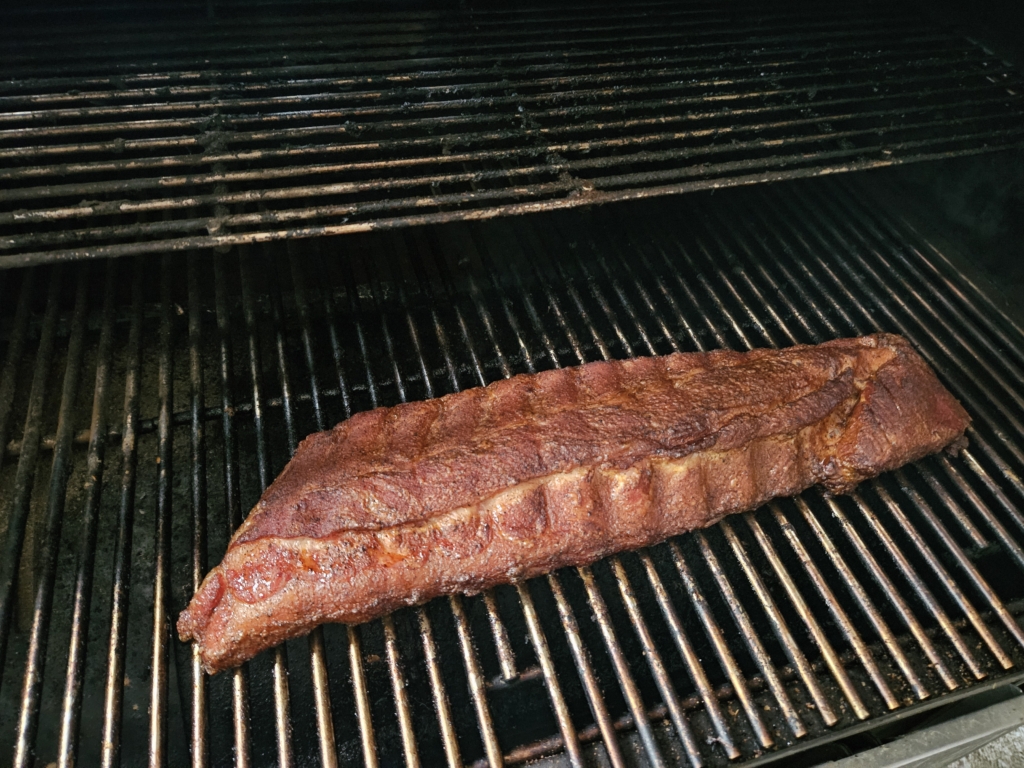
- To tell if the ribs are done, we prefer to use the "bend test." Use tongs to pick up one end of the slab of ribs, then bend them slightly. If they are ready, the slab will bow until the meat starts to crack on the surface. If they are still tough, allow them to cook for another 30 minutes before testing again. Cook longer if needed. Sometimes you get a tough slab!
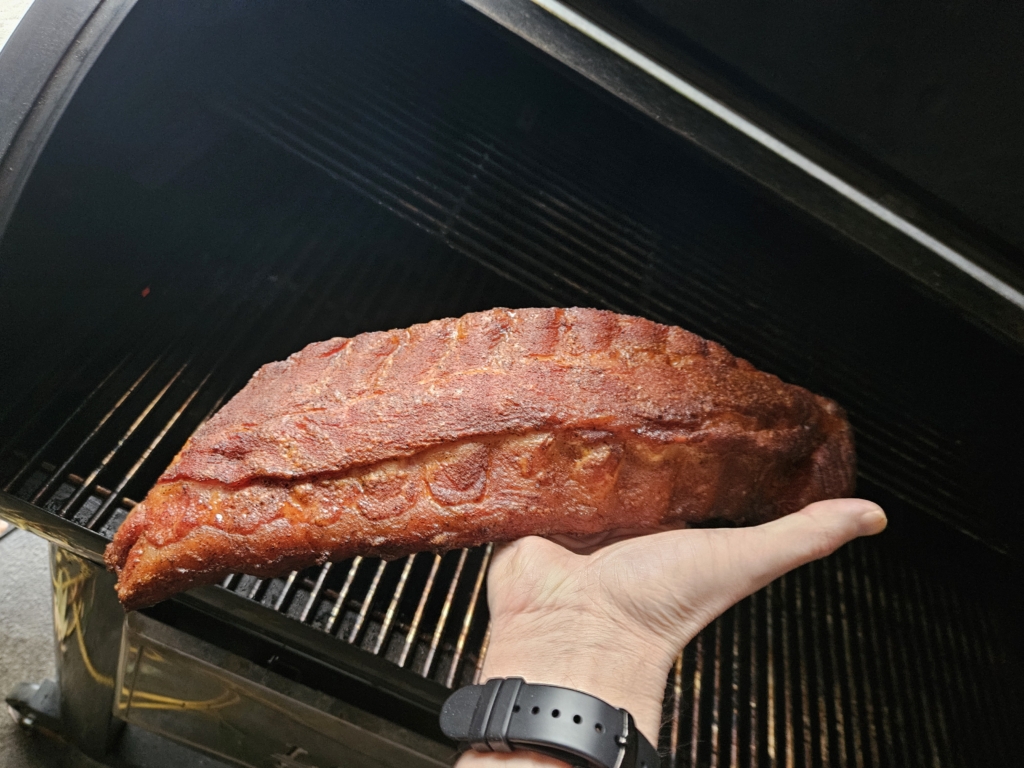
- Serve. Once they arey tender, remove the ribs from the smoker or grill, then slice and serve.

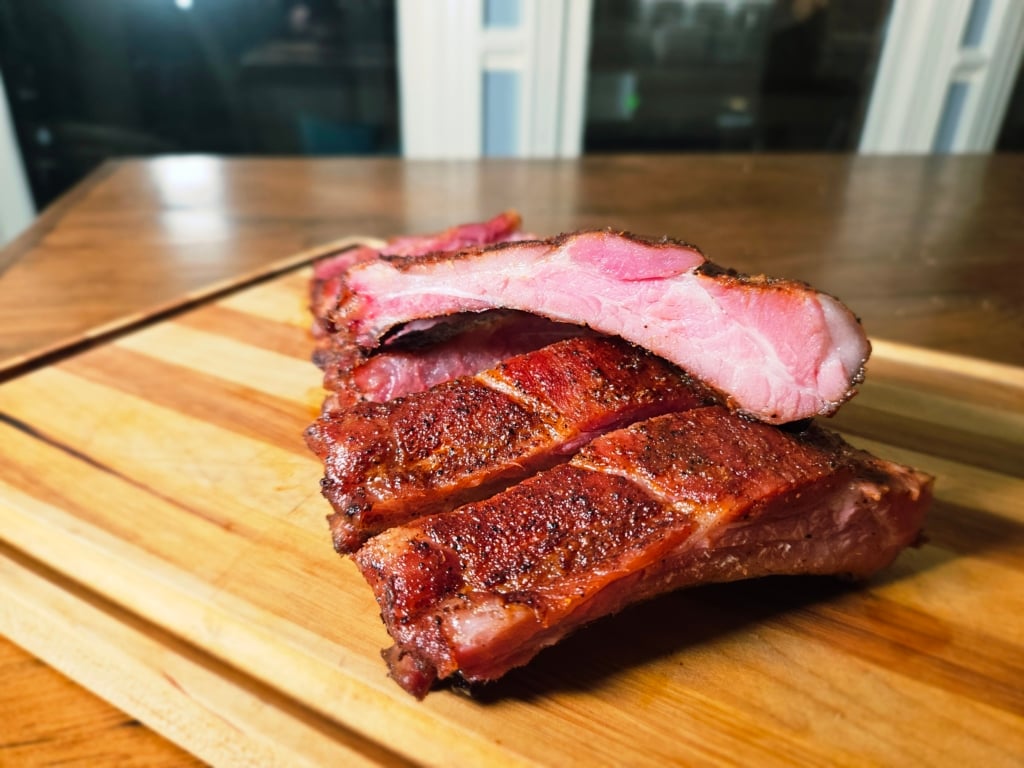
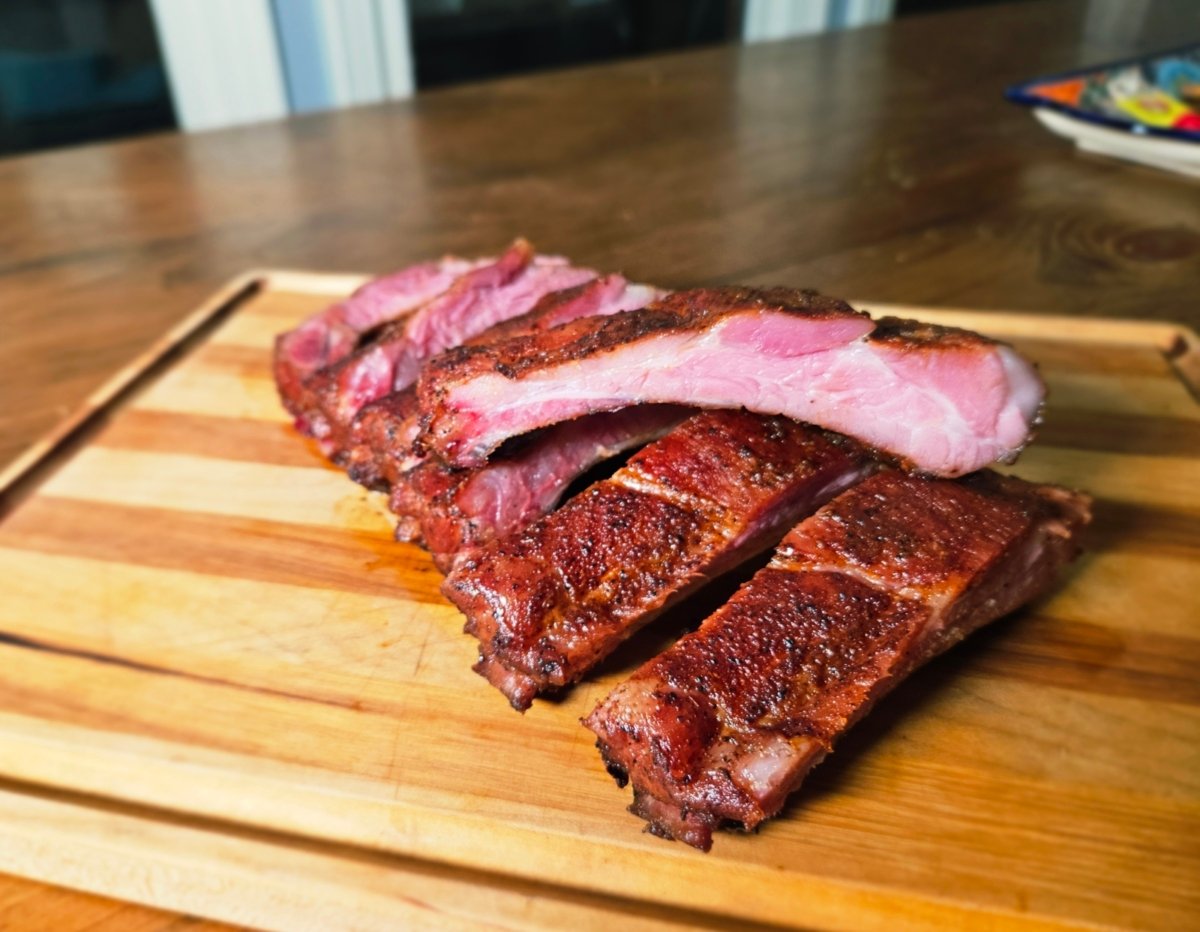
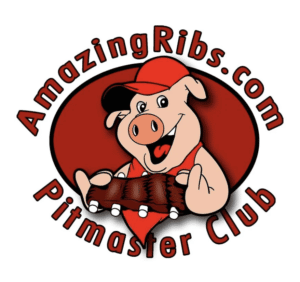
High quality websites are expensive to run. If you help us, we’ll pay you back bigtime with an ad-free experience and a lot of freebies!
Millions come to AmazingRibs.com every month for high quality tested recipes, tips on technique, science, mythbusting, product reviews, and inspiration. But it is expensive to run a website with more than 2,000 pages and we don’t have a big corporate partner to subsidize us.
Our most important source of sustenance is people who join our Pitmaster Club. But please don’t think of it as a donation. Members get MANY great benefits. We block all third-party ads, we give members free ebooks, magazines, interviews, webinars, more recipes, a monthly sweepstakes with prizes worth up to $2,000, discounts on products, and best of all a community of like-minded cooks free of flame wars. Click below to see all the benefits, take a free 30 day trial, and help keep this site alive.
Post comments and questions below
1) Please try the search box at the top of every page before you ask for help.
2) Try to post your question to the appropriate page.
3) Tell us everything we need to know to help such as the type of cooker and thermometer. Dial thermometers are often off by as much as 50°F so if you are not using a good digital thermometer we probably can’t help you with time and temp questions. Please read this article about thermometers.
4) If you are a member of the Pitmaster Club, your comments login is probably different.
5) Posts with links in them may not appear immediately.
Moderators